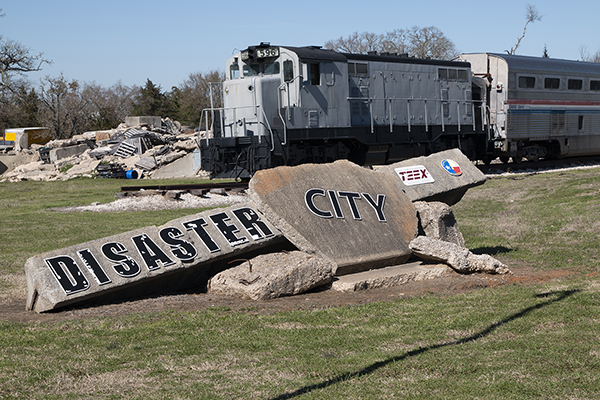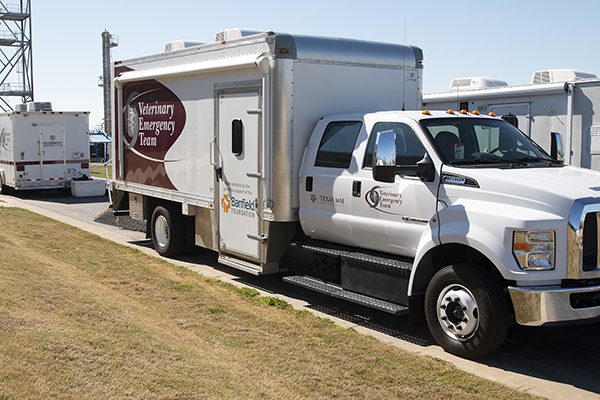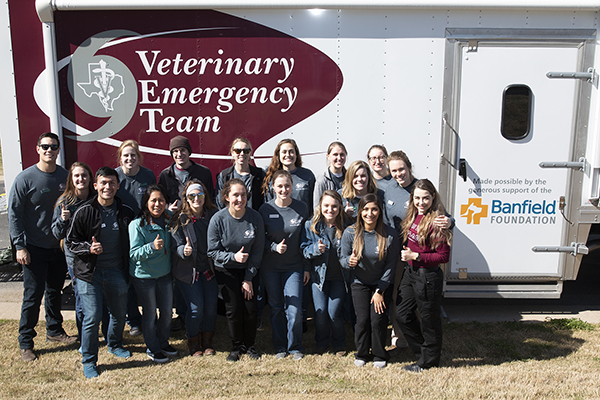CVM Students Participate in Annual Disaster Day Training
Story by Madeline Patton, CVMBS Communications

Veterinary students from the Texas A&M College of Veterinary Medicine & Biomedical Sciences (CVM) and the Student Veterinary Response Team (SVRT) put their knowledge and skills to the test on Feb. 14 during the Health Science Center’s (HSC) Disaster Day event, an annual interprofessional, interdepartmental disaster simulation.
Held at the Texas A&M Engineering Service’s Brayton Fire Training Field and Disaster City—a mock city with collapsed building structures, derailed train, and other disaster scenario facilities—Disaster Day provides a unique training experience for students from all of Texas A&M’s health and medical disciplines by providing an opportunity to practice critical skills needed during crisis situations.
“Disaster Day is a good experience for the veterinary students,” said Dr. Deb Zoran, a professor in the CVM Department of Small Animal Clinical Sciences (VSCS) and a member of the Veterinary Emergency Team (VET), which supports CVM students’ involvement by providing some of the team’s equipment for the students to use. “It gives them a chance to practice some of their disaster skills, such as triaging and thinking about a case in a disaster environment and how it would be different in a real hospital.”
This year’s scenario involving the city of Dallas experiencing a 6.1 magnitude earthquake that caused a building collapse, a derailed train, and a potential nuclear disaster.
Sarah Manning, second-year veterinary student and SVRT president, played a major role in writing the 15 different veterinary cases and working with the HSC to create an integrative scenario for all departments involved.

“I was able to put a public health play on the veterinary cases because we really wanted to bring in the interdisciplinary Global One Health aspect to the event, not only because we’re all working together so closely but because this is a very integrated interprofessional simulation,” Manning said. “Global One Health is a big component of it, so when possible, I wrote in components to involve medicine, nursing, and public health anywhere and everywhere we could.”
Actors were given a predetermined medical scenario for which the medical and nursing students must find a solution. In order to integrate the veterinary medicine aspect of Disaster Day, some of the actors were assigned an animal that was also involved in the scenario. This integration brought an emphasis of communication between the veterinary students and the owners of the injured animals.
During an actual disaster, pet owners may not want to be separated from their pets out of fear that they will never find them again, so it was important that the students were able to see that the animals were being appropriately cared for while encouraging the owners to seek medical attention if they needed it, according to Manning.
The SVRT members acted as a veterinary health care provider, treating the injured animals while providing emotional and, potentially, physical support for the owners.
“Not only are veterinary student having to cater to the medical needs of these animals, they’re actually having to work with these actors that are pet owners and have just been through a disaster, too,” Manning said.
Morgan Marshall, a second-year veterinary student and SVRT member, describes Disaster Day as “controlled chaos.”
From members of the Corps of Cadets, nursing, pharmacy, and medical students, as well as those overseeing the event, everyone had a job, and those jobs were taken seriously, as if a real-life disaster had taken place.
“Along with my team, I was charged with taking care of all of the animal cases that were rescued from the disaster setting,” Marshall said. “We had to assign each patient with a triage rating based on the severity of its injuries, come up with a treatment plan, and communicate with any owners we could associate with the patient.”
Marshall explained that a goal for Disaster Day is to give all of Texas A&M’s health care profession schools a chance to play out a multidisciplinary response to a devastating event.

“This will hopefully create human and animal health professionals, as well as future first responders, who understand the dynamic chaos of working together to save lives in a disaster setting,” Marshall said. “This experience also gives us a chance to make mistakes and ask lots of questions when the stakes are low, so that when we get into a real-world experience, we can be confident in our actions.
“In my opinion, Disaster Day is very realistic for what a real disaster would be like,” Marshall said. “There were lots of people screaming and running here and there, trying their best to communicate with each other to help people and animals.”
In what she calls the most memorable moment of the day, Marshall and her classmate were charged with the responsibility of finding the owner of a dog that was unlikely to survive because of the severity of its injuries. In this case, both the pet and the owner were exposed to a live wire during the earthquake.
“We knew it would be a difficult conversation, but we were not really prepared for what we found,” Marshall said. “When we came into the hospital and asked the nurse if we could speak to their patient, because her animal was very critical, we were informed that the human patient had ‘passed away.’
“That was a surreal moment, realizing that this simulation is a real representation of a disaster situation in which you cannot save every human or animal life,” Marshall continued. “It made me very appreciative for the people who devote themselves every day to emergency work and grateful for the change to see a glimpse of that world.”
###
For more information about the Texas A&M College of Veterinary Medicine & Biomedical Sciences, please visit our website at vetmed.tamu.edu or join us on Facebook, Instagram, and Twitter.
Contact Information: Jennifer Gauntt, Director of Communications, Texas A&M College of Veterinary Medicine & Biomedical Sciences; jgauntt@cvm.tamu.edu; 979-862-4216


